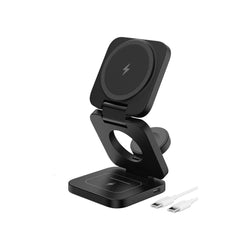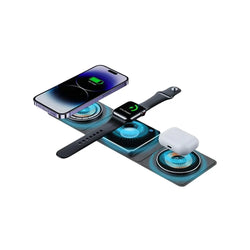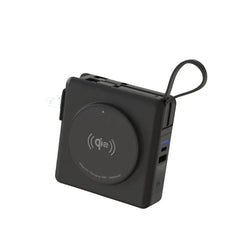Wireless charging has quickly evolved from a luxury to an everyday necessity. For Apple users managing iPhones, Apple Watches, and AirPods, the 3 in 1 wireless charger has become a popular choice. But within this category, two designs dominate: the foldable wireless charger and the fixed wireless stand. Both promise to simplify charging, but which is better for your lifestyle? Let’s break it down with research, pros and cons, and real-world use cases to help you choose between them.
Understanding the 3 in 1 Wireless Charger
At its core, a 3 in 1 wireless charger combines three functions into one hub:
-
iPhone charging pad (MagSafe or Qi-certified)
-
Apple Watch dock with magnetic alignment
-
AirPods pad for wireless cases
Instead of juggling multiple adapters, one stand manages all three. A 2024 Counterpoint Research study revealed that multi-device wireless charging adoption is growing at 25% annually, with 3-in-1 hubs leading the category.
But how the hub is designed, foldable or fixed, makes a big difference.
Foldable Wireless Chargers
A foldable wireless charger is designed with hinges or flexible layouts that can collapse flat for portability. Some fold like a book, others roll into compact pads.
Pros
-
Travel-Friendly: Lightweight and slim, easy to pack.
-
Versatile Layouts: Can open flat or stand devices at an angle.
-
Minimalist Design: Great for users who want portability without bulk.
-
Shared Charging: Flat layout lets two people charge devices at once.
Cons
-
Durability: Hinges and folds can wear out over time.
-
Stability: Phones may slip if the foldable surface isn’t sturdy.
-
Heat Management: Foldable pads can trap more heat in small spaces.
-
Less Premium Build: Often made of lightweight plastic for portability.
Best For
-
Frequent travelers
-
Students in shared spaces
-
Professionals needing portable charging setups
Fixed Wireless Chargers
A fixed wireless charger (also called a charging stand) is a solid, non-foldable hub designed to sit permanently on a desk or nightstand.
Pros
-
Sturdy Build: Durable materials like aluminum and glass.
-
Consistent Charging: Stable design ensures devices stay aligned.
-
Aesthetic Appeal: Premium look fits desks, offices, and bedrooms.
-
Better Heat Dissipation: Rigid builds often include vents or cooling.
Cons
-
Less Portable: Bulky compared to foldable chargers.
-
Fixed Angles: Limited flexibility in device positioning.
-
Takes More Space: Not ideal for minimal travel setups.
Best For
-
Home or office use
-
Users prioritizing style and durability
-
Heavy daily Apple ecosystem users
Magnetic 3 in 1 Charger: The Game-Changer
The rise of the magnetic 3 in 1 charger has added another layer of convenience. Built with MagSafe or similar magnetic technology, these chargers snap devices into place automatically.
Research from the Wireless Power Consortium shows that magnetic alignment increases charging efficiency by 30: 40% compared to non-aligned pads. That means fewer interruptions, faster speeds, and better heat control.
Whether foldable or fixed, a magnetic 3 in 1 charger ensures your iPhone, Apple Watch, and AirPods charge properly every time.
Performance Comparison: Foldable vs Fixed
|
Feature |
Foldable Wireless Charger |
Fixed Wireless Charger |
|
Portability |
Compact, easy to travel with |
Bulky, not travel-friendly |
|
Durability |
Hinges may weaken over time |
Solid, built for long-term use |
|
Stability |
Less sturdy, devices may shift |
Secure device positioning |
|
Charging Speed |
Reliable but heat can build up |
More consistent cooling, stable speeds |
|
Design Appeal |
Minimal, functional |
Premium, stylish |
|
Best For |
Travelers, light users |
Home, office, heavy daily charging |
Research Insights: User Preferences
-
Statista 2024 survey: 58% of Apple users said they prefer fixed stands for home use due to stability and aesthetics.
-
Digital Trends 2023 poll: 65% of frequent travelers chose foldable wireless chargers for portability.
-
MarketWatch forecast: The magnetic 3 in 1 charger category is expected to grow fastest, with an adoption rate of 35% year-over-year.
This shows the decision isn’t about which one is universally “better”, it’s about which fits your lifestyle.
Real-Life Scenarios
-
Business Traveler: A consultant flying weekly prefers a foldable wireless charger that slips into a laptop bag.
-
Work-From-Home Professional: A designer working long hours keeps a fixed 3 in 1 wireless charger on the desk for daily reliability.
-
College Student: Lives in a shared dorm, uses a foldable pad for compactness.
-
Family Household: Parents use a fixed hub in the living room as a shared charging station.
Both types shine in different environments.
The Future of Multi-Device Wireless Charging
Looking ahead, the 3 in 1 wireless charger will evolve with the Qi2 standard. This next-gen system ensures:
-
Better alignment: Stronger magnets reduce misplacement.
-
Faster speeds: Charging beyond 30W possible.
-
Universal support: Cross-brand compatibility, not just Apple.
Expect future foldable wireless chargers to become sturdier with better cooling systems, while fixed chargers will integrate into furniture, cars, and public spaces.
The magnetic 3 in 1 charger will remain central, offering a balance of speed, safety, and ease of use.
Challenges Still Ahead
Even with progress, challenges exist:
-
Heat Control: Faster wireless charging still produces heat.
-
Energy Loss: Wireless is slightly less efficient than wired, though Qi2 narrows the gap.
-
Price Point: Premium chargers can cost 5: 7x more than cables.
-
Durability: Foldable hinges remain a weak point for frequent travellers.
These hurdles are being addressed, making each new generation more reliable.
Final Thoughts
So, foldable vs fixed, which is better? The answer depends on how you use your devices.
-
Choose a foldable wireless charger if you travel often, work in multiple locations, or need portability.
-
Choose a fixed 3 in 1 wireless charger if you want durability, aesthetics, and consistency at home or the office.
-
For both, opting for a magnetic 3 in 1 charger ensures proper alignment and faster, safer charging.
Either way, both options bring order to the chaos of multiple Apple devices. With research pointing to rapid adoption, it’s clear that multi-device charging is not just a trend it’s the future.




